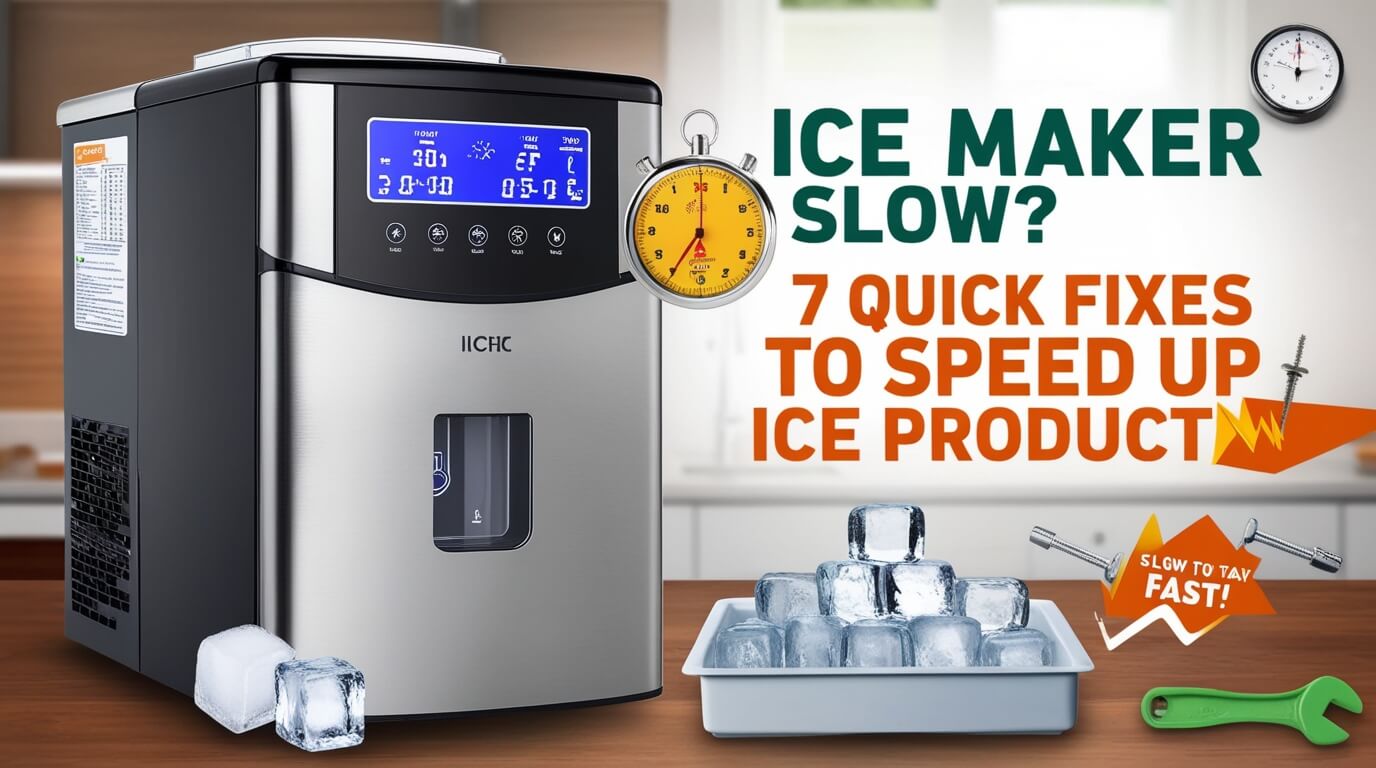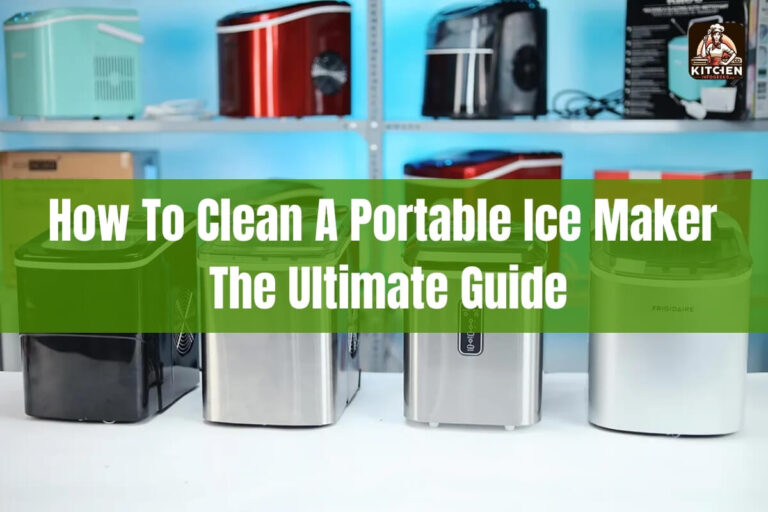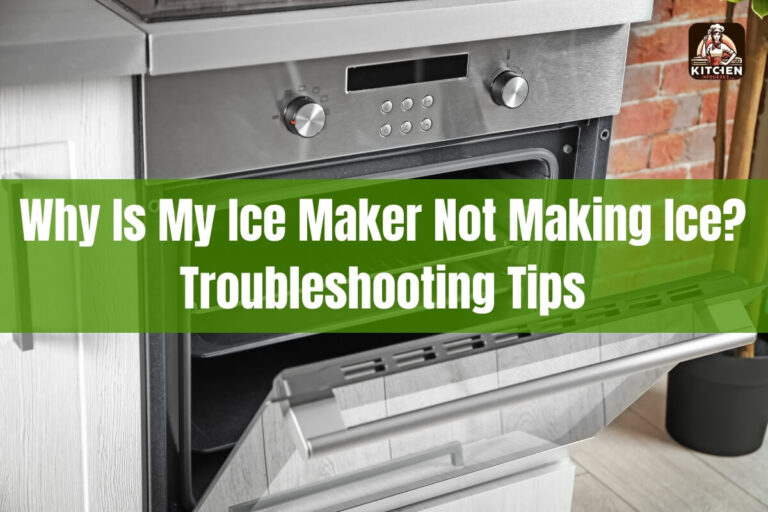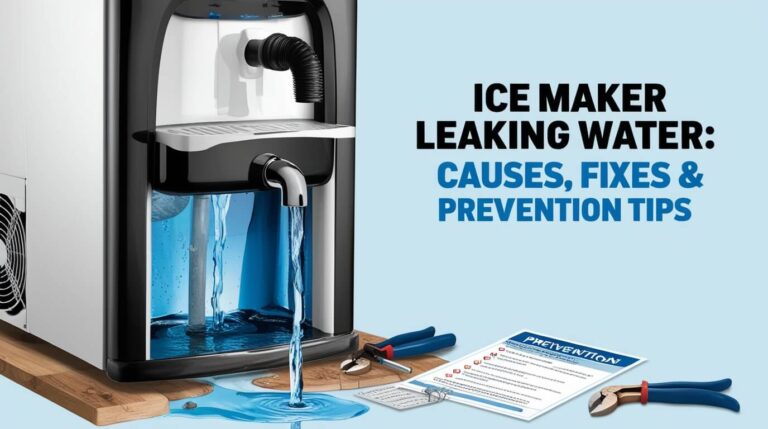
Is your ice maker taking ages to make ice? Don’t fret – you might be able to fix it yourself. Most slow ice makers have simple problems:
- Wrong freezer temp
- Water supply trouble
- Clogged filter
Let’s find out why your ice maker is slow and how to speed it up. We’ll cover how they work, what slows them down, and ways to fix them. This info will help you understand and maybe even repair your ice maker.
Ice Maker
Before we tackle the slow ice production problem, let’s get to know your ice maker a little better.
How Does an Ice Maker Work?
Ice makers are pretty clever devices. They work by filling a mold with water, freezing it, and then dumping the ice into a collection bin. Here’s a quick breakdown of the process:
- Water flows into the ice maker through a supply line.
- The water fills molds in the ice maker tray.
- When the water freezes, a thermostat signals it’s ready.
- A heating element warms the molds slightly to release the ice.
- An ejector arm pushes the ice cubes out into the collection bin.
- The process starts over until the bin is full.
It’s a simple yet effective system. But when one part of this process slows down, you end up waiting longer for your ice.
Normal Ice Production Rates
So, how fast should your ice maker be working? Most refrigerator ice makers can produce 8 to 10 cubes every 90 minutes. That’s about 100 to 130 cubes in a day. Some high-end models can make even more.
If your ice maker is producing less than 50 cubes a day, it’s definitely underperforming. Time to put on your detective hat and figure out why!
Common Reasons for Slow Ice Production
Let’s explore the usual suspects behind a sluggish ice maker.
Incorrect Freezer Temperature
Your freezer needs to be cold enough to make ice quickly. The ideal temperature is between 0°F and 5°F (-18°C to -15°C). If it’s warmer than this, ice production will slow down.
Water Supply Issues
No water means no ice. A kinked water line, low water pressure, or a partially closed water valve can all lead to slow ice production.
Clogged Water Filter
A dirty water filter can restrict water flow to your ice maker. This is especially common in areas with hard water.
Overfilled or Empty Freezer
Believe it or not, both an overstuffed and an empty freezer can slow down ice production. A packed freezer restricts air circulation, while an empty one makes it harder for the freezer to maintain a consistent temperature.
Dirty Condenser Coils
These coils help your freezer stay cold. When they’re covered in dust or grime, they can’t do their job effectively, leading to warmer temperatures and slower ice production.
Faulty Water Inlet Valve
This valve controls the water flow into your ice maker. If it’s not opening fully, your ice maker won’t get enough water to work efficiently.
Improperly Installed Ice Bucket
If your ice bucket isn’t sitting correctly in its slot, it can prevent the ice maker from working properly.
Troubleshooting Your Slow Ice Maker
Now that we know what might be causing the problem, let’s roll up our sleeves and fix it!
Check and Adjust Freezer Temperature
Start by checking your freezer’s temperature. If it’s above 5°F, adjust it to a colder setting. Give it 24 hours to stabilize before checking ice production again.
Inspect Water Supply Line and Pressure
Take a look at the water line leading to your refrigerator. Make sure it’s not kinked or bent. Also, check that the shut-off valve is fully open. If you have low water pressure throughout your home, you might need to call a plumber.
Replace Water Filter
If you can’t remember the last time you changed your water filter, it’s probably time for a new one. Most manufacturers recommend changing the filter every six months.
Organize Your Freezer Contents
Aim to keep your freezer about 70-80% full. This helps maintain a stable temperature. If it’s empty, consider adding some water bottles. If it’s too full, remove some items to improve air circulation.
Clean Condenser Coils
Unplug your refrigerator and locate the condenser coils. They’re usually at the back or bottom of the fridge. Use a vacuum cleaner or a brush to remove dust and debris.
Examine Water Inlet Valve
This one’s a bit trickier and might require a professional. But if you’re handy, you can check if the valve is getting power and opening properly.
Ensure Proper Ice Bucket Installation
Remove the ice bucket and reinstall it. Make sure it clicks into place and sits level.
DIY Fixes for a Slow Ice Maker
Sometimes, a little DIY can go a long way in fixing your slow ice maker.
Thawing a Frozen Water Line
If you suspect your water line is frozen, unplug the refrigerator and locate the water line. Use a hair dryer on low heat to gently thaw any ice blockage.
Cleaning the Ice Maker Assembly
Turn off the ice maker and remove any ice from the bin. Use a soft cloth dampened with a mixture of warm water and mild dish soap to clean the ice maker parts. Dry thoroughly before turning it back on.
Descaling for Hard Water Issues
If you live in an area with hard water, mineral buildup could be slowing down your ice maker. You can use a mixture of water and vinegar to descale the system. Just be sure to run several cycles of plain water afterward to rinse it thoroughly.
When to Call a Professional
While many ice maker issues can be fixed at home, some problems require expert attention.
Signs of Serious Ice Maker Problems
If you’ve tried the DIY fixes and your ice maker is still slow, or if you notice any of these signs, it’s time to call in the pros:
- Strange noises coming from the ice maker
- Water leaking inside the freezer
- Ice that smells or tastes bad
- Ice maker not working at all
Choosing a Reliable Appliance Repair Service
When selecting a repair service:
- Look for certified technicians
- Check online reviews
- Ask about warranties on parts and labor
- Get a written estimate before work begins
Remember, a good repair service can often fix your ice maker for less than the cost of a new refrigerator.
Maintenance Tips to Prevent Slow Ice Production
An ounce of prevention is worth a pound of cure, especially when it comes to appliances.
Regular Cleaning Schedule
Mark your calendar to clean your ice maker every 3-6 months. This includes wiping down the ice bin, cleaning the water filter housing, and checking for any mineral buildup.
Proper Usage Habits
Don’t overload your freezer, and try to minimize how often you open the freezer door. Every time you open it, warm air enters and makes your freezer work harder.
Seasonal Adjustments
In summer, you might need to set your freezer a degree or two colder to keep up with increased ice demand. Just remember to adjust it back when the weather cools down.
Alternatives to Built-in Ice Makers
If you’re consistently needing more ice than your refrigerator can produce, you might want to consider alternatives.
Portable Ice Makers
These countertop appliances can produce ice quickly and don’t require a water line connection. They’re great for parties or if you use a lot of ice regularly.
Benefits and Drawbacks
Portable ice makers are convenient and can produce ice faster than most built-in models. However, they take up counter space and need to be filled manually. They also don’t keep ice frozen for long periods, so you’ll need to use the ice relatively quickly.
Conclusion
A slow ice maker can be frustrating, but with a little knowledge and effort, you can often get it back up to speed. Regular maintenance, proper usage, and quick action when problems arise will help ensure you always have ice when you need it.
Remember, if your ice maker is slow to make ice, start with the simple fixes: check the temperature, inspect the water supply, and clean or replace the filter. If these don’t work, don’t hesitate to call in a professional. With proper care, your ice maker should be able to keep your drinks cold for years to come.
Stay cool, and happy troubleshooting!






